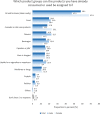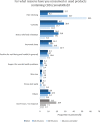Usage and health perception of cannabidiol-containing products among the population in Germany: a descriptive study conducted in 2020 and 2021
- PMID: 37996800
- PMCID: PMC10666397
- DOI: 10.1186/s12889-023-17142-0
Usage and health perception of cannabidiol-containing products among the population in Germany: a descriptive study conducted in 2020 and 2021
Abstract
Background: Cannabidiol (CBD), a non-intoxicating substance of Cannabis sativa L., is gaining consumer attention. Yet, legal regulations in the EU are complex and questions of potential health risks remain partly unanswered. In Germany, little is known about people who use CBD products. The aim of this cross-sectional study was to gain insight into the user group of CBD, reasons for consumption and risk perception towards CBD-containing products.
Methods: The study consisted of two parts: In the first part of the study, the prevalence of CBD awareness and usage in Germany was estimated using a telephone survey and a population-representative sample of n = 1,011 respondents. Based on these results, n = 2,000 participants being aware of CBD were surveyed with an online questionnaire in the second part of the study to examine usage and perception of CBD in users and non-users.
Results: When the study was conducted at the end of 2020 and beginning of 2021, 40.2% of the German participants had already heard of products containing CBD, and 11.4% had actually used them. 42.1% of the users consumed such products regularly, at least once a week, primarily orally via oils or tinctures, and purchased them mainly online. Besides curiosity - addressed especially in young adults - anticipated health benefits including pain and stress relief were main reasons for use. More than half of the study participants perceived the health benefits of CBD use as high or very high. In contrast, the health risks were rated as low or very low by most respondents. Assumptions about official testing for safety as well as physical effects of CBD-containing products varied between users and non-users.
Conclusion: About one in nine people in Germany uses CBD-containing products. Given reasons for consumption and perception of potential health risks and benefits suggest that people are insufficiently informed about CBD-containing products. The results of the study indicate that risk communication is needed to raise awareness for the topic and to inform (potential) users.
Keywords: CBD; Cannabidiol; Consumption; Germany; Online survey; Risk perception.
© 2023. The Author(s).
Conflict of interest statement
The authors declare no competing interests.
Figures








Similar articles
-
Cannabidiol use and perceptions in France: a national survey.BMC Public Health. 2022 Aug 29;22(1):1628. doi: 10.1186/s12889-022-14057-0. BMC Public Health. 2022. PMID: 36038869 Free PMC article.
-
Recreational Cannabidiol: Awareness, Prevalence of use, and Associated Factors in a Representative Sample of the German Population.Subst Use Misuse. 2022;57(9):1417-1424. doi: 10.1080/10826084.2022.2083175. Epub 2022 Jun 10. Subst Use Misuse. 2022. PMID: 35686726
-
CBD (Cannabidiol) Product Attitudes, Knowledge, and Use Among Young Adults.Subst Use Misuse. 2020;55(7):1138-1145. doi: 10.1080/10826084.2020.1729201. Epub 2020 Feb 24. Subst Use Misuse. 2020. PMID: 32093530
-
Benefits, toxicity and current market of cannabidiol in edibles.Crit Rev Food Sci Nutr. 2023;63(22):5800-5812. doi: 10.1080/10408398.2021.2024493. Epub 2022 Jan 6. Crit Rev Food Sci Nutr. 2023. PMID: 34989307 Review.
-
The current understanding of the benefits, safety, and regulation of cannabidiol in consumer products.Food Chem Toxicol. 2021 Nov;157:112600. doi: 10.1016/j.fct.2021.112600. Epub 2021 Oct 6. Food Chem Toxicol. 2021. PMID: 34626752 Free PMC article. Review.
Cited by
-
The impact of cannabidiol placebo on amygdala-based neural responses to an acute stressor.J Psychopharmacol. 2024 Nov;38(11):935-948. doi: 10.1177/02698811241287557. Epub 2024 Oct 14. J Psychopharmacol. 2024. PMID: 39400103 Free PMC article. Clinical Trial.
-
Over the counter CBD products in Germany: an exploratory survey about consumption patterns and health related effects.Front Pharmacol. 2025 May 21;16:1571025. doi: 10.3389/fphar.2025.1571025. eCollection 2025. Front Pharmacol. 2025. PMID: 40469987 Free PMC article.
-
Acceptability of and attitudes to the therapeutic use of cannabis and cannabidiol in people with Parkinson's disease: A French survey.Clin Park Relat Disord. 2024 Nov 20;11:100286. doi: 10.1016/j.prdoa.2024.100286. eCollection 2024. Clin Park Relat Disord. 2024. PMID: 39687323 Free PMC article.
-
Cannabidiol in Foods and Food Supplements: Evaluation of Health Risks and Health Claims.Nutrients. 2025 Jan 29;17(3):489. doi: 10.3390/nu17030489. Nutrients. 2025. PMID: 39940347 Free PMC article. Review.
-
Cannabidiol Use Among Older Adults: Associations with Cannabis Use, Physical and Mental Health, and Other Substance Use.Clin Gerontol. 2024 Nov 22:1-13. doi: 10.1080/07317115.2024.2429595. Online ahead of print. Clin Gerontol. 2024. PMID: 39575982
References
-
- Lange BM, Zager JJ. Comprehensive inventory of cannabinoids in Cannabis sativa L.: can we connect genotype and chemotype? Phytochem Rev. 2022;21(4):1273–1313. doi: 10.1007/s11101-021-09780-2. - DOI
-
- European Court of Justice. Judgment of the Court (Fourth Chamber) of 19 November 2020 (request for a preliminary ruling from the Cour d’appel d’Aix-en-Provence – France). 2020. Available from: https://curia.europa.eu/juris/document/document.jsf?docid=236909&mode=re.... Last Accessed 26 Jan 2023.
MeSH terms
Substances
LinkOut - more resources
Full Text Sources

